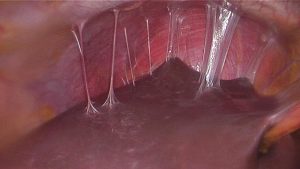 Refers to right upper quadrant pain that may be pleuritic in young, sexually active women.
Refers to right upper quadrant pain that may be pleuritic in young, sexually active women.
Fitz-Hugh-Curtis syndrome is a rare disorder involving pelvic inflammatory disease (PID) causing swelling of the tissue around the liver, perihepatitis syndrome.
Most often it is caused by sexually transmitted infections (STIs) like chlamydia and gonorrhea, and is associated with inflammation of the uterus, ovaries, fallopian tubes, cervix, or vagina.
It is usually caused by Chlamydia trachomatis or Neisseria gonorrhoeae, though other bacteria such as Bacteroides, Gardnerella, E. coli and Streptococcus have also been found to cause Fitz-Hugh-Curtis syndrome on occasion.
These bacterial pathogens allow bacteria from the vagina into the uterus and fallopian tubes, causing infection and inflammation.
Occasionally, this inflammation can cause scar tissue to form on Glisson’s capsule, a thin layer of connective tissue surrounding the liver.
Fitz-Hugh–Curtis syndrome occurs almost exclusively in women.
Major symptom and signs include an acute onset of right upper quadrant abdominal pain aggravated by breathing, coughing or laughing.
The inflammation can spread to the capsule of the liver or the tissues surrounding the liver in the abdomen, and the diaphragm.
It is marked by sudden, severe pain in the upper right quadrant.
There is usually also tenderness on palpation of the right upper abdomen and tenderness to percussion of the lower ribs which protect the liver.
Pain on the right shoulder and right arm may be present.
Clinically there is usually also tenderness on palpation of the right upper abdomen and tenderness to percussion of the lower ribs which protect the liver.
There is often no or only minimal pelvic pain, vaginal discharge or cervical motion tenderness.
Occurs almost exclusively in women.
It is usually caused by gonorrhoea (acute gonococcal perihepatitis) or chlamydia bacteria.
Occasionally, this inflammation can cause scar tissue to form on Glisson’s capsule.
About 50-75% of cases are caused by Chlamydia trachomatis infection.
Ten percent of cases result from Neisseria gonorrhea infection.
A complication of pelvic inflammatory disease in 5 to 10% of cases.
Other symptoms might include:
Fever
Chills
Night sweats
Nausea and vomiting
Hiccups
Headaches
Malaise
Symptoms of PID, but there is often no or only minimal pelvic pain, vaginal discharge or cervical motion tenderness, which may lead to the diagnosis being missed: This may be due to infectious bacteria bypassing pelvic structures on the way to the liver capsule.
Women of childbearing age who have PID have the biggest chance of developing Fitz-Hugh-Curtis syndrome.
Ultrasound is the preferred imaging study for acute right upper quadrant pain but its diagnostic acuracy is poor in regards to hepatic inflammation, capsular abnormalities at the dome of the liver, and small abscesses.
CT scans are the most accurate to demonstrate the hepatic inflammation and capsular enhancement, and also can evaluate the pelvic area for possible tubo-ovarian abscesses.
Bactericides spp., and organisms such as Gardnerella, E. coli, and streptococcus may also play a role in some cases but are less commonly involved.
Diagnosis difficulties:
Abdominal ultrasound will typically be normal.
Liver function tests will typically be normal or unchanged from baseline.
Testing for pulmonary embolism will be normal.
CT of the abdomen with IV contrast may show subtle enhancement of the liver capsule.
Testing for gonorrhea and chlamydia should be performed to make the diagnosis, with endocervical or low vaginal swabs.
Antibody testing is rarely required.
Laparoscopy is also rarely required, but may be performed when the diagnosis is uncertain and may reveal string adhesions of parietal peritoneum to liver.
Treatment involves a course of antibiotics to cover the appropriate organisms, typically ceftriaxone plus azithromycin.
Laparoscopy for lysis of adhesions may be performed for refractory pain.
D-dimer usually is markedly elevated.
Testing for gonorrhea and chlamydia should be performed.
Treatment involves a course of antibiotics to cover the appropriate organisms, typically ceftriaxone plus azithromycin.
Laparoscopy for lysis of adhesions may be performed for refractory pain.
